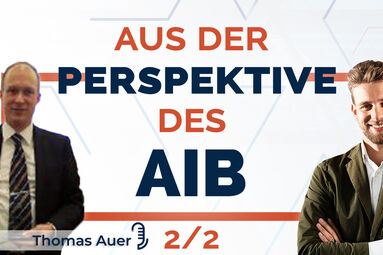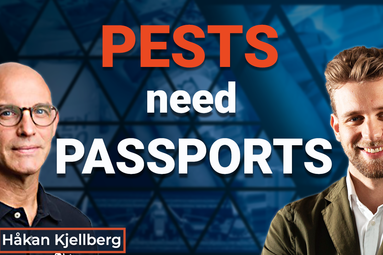Many ‘Talking Pest Management’ listeners have requested a guest from the Amerian Institute of Baking (AIB for short) in recent weeks. The AIB standard is considered one of the most important and detailed standards in the food industry. For internationally active companies in particular, this standard is essential in order to be able to hold their own in the global market. With Thomas Auer from AIB, we were able to win over a very experienced auditor to answer Daniel Schröer’s questions.
The American Institute of Baking was founded in 1919 and has over 100 years of company history. Initially founded as a service provider for the baking industry, only a short time later an audit service was added to AIB’s range of services, from which the now internationally recognized AIB Standard has developed. In 2021, AIB employs over 100 auditors auditing in over 120 countries worldwide. One of them is Thomas Auer, who has been an auditor for more than 14 years.
Before joining AIB almost 15 years ago, Thomas coordinated audits for a large dairy company in Paris, until at one point he approached AIB’s general manager in a very unconventional way to see if there was an opportunity to become an auditor there. He reports that at the time, he initially flew to the U.S. for 14 days of training to get started. Today, this first step can also take place in Europe as an entry at the AIB.
Getting started as an auditor
In the first three months of their employment, new auditors accompany different colleagues in several customer situations and start auditing sub-areas. This is followed by independent audits under the watchful eye of experienced colleagues, before a “baptism of fire” audit under the scrutiny of the general manager takes place. Even after that, all reports are still proofread for a few months. With this extensive training, the AIB ensures the very high quality in the audits.
Daniel reports that from his own perception the AIB standard is the “ultimate” in the market and asks Thomas to go into more detail about the standard.
The AIB standard is divided into five chapters:
- Operating methods and personnel practices
- Maintenance of food safety
- Cleaning practices
- Integrated Pest Management
- Suitability of the prerequisite and food safety programs.
Daniel and Thomas want to focus the conversation on integrated pest management. Unlike many other standards, the AIB has a separate chapter on pest control. One of the special requirements with regard to pest control at the AIB is that no poison may be used indoors. Instead, the use of mechanical traps or laying trap systems is recommended.
Sophisticated points system
Within the scope of auditing companies, the AIB uses a sophisticated scoring system. In each chapter 200 points can be achieved, in total 1,000 points. The evaluation is done in 5-point increments. The word that no one wants to hear during an audit is ‘unsatisfactory’. Equivalent to ‘failed’. A minimum of 135 points must be earned in each chapter for credit, regardless of scores in the other chapters.
In addition, there are also some automatic exclusion factors that lead to the ‘unsatisfactory’. These include, for example, a conspicuous number of house or fruit flies, rodents sighted, cockroaches in the product environment or pesticides that are not used in accordance with the specifications, i.e. improperly disposed of, for example.
Daniel and Thomas look more closely at integrated pest management during the interview and discuss the influences of other subsectors on it. Thomas points out that the building envelope is the most important point for successful pest control. He also believes that vegetation-free strips around company buildings are very relevant and play an important role in pest control.
One system that is used again and again is the so-called ‘ICE Methodology’.
This stands for:
I = Identification
C = Control
E = Elimination
In Thomas’ view, there should also be a genuine partnership between the pest controller and the customer. He advises companies to stick with service providers for the long term, as he believes it is much more relevant for the pest control company to know the business well than to regularly choose the cheapest provider.
Holistic approach to integrated pest management
The two go on to discuss a recent CEPA campaign that views pest management as holistic due to its complexity and sees the approach to “Integrated Pest Management” as a pyramid (Envelope, Sanitation, Monitoring, Control). This view is in line with the philosophy of the AIB.
Looking at how the industry has evolved over the past five to ten years, Thomas notes above all that almost all documentation systems are now digital, whereas in the past most was paper-based. When asked by Daniel whether he sees similar revolutionary brands in the market such as Airbnb, WhatsApp or Uber, Thomas replies that he perceives the offerings to be rather more broadly spread, as many companies also use in-house software.
The overall objective
Thomas sees the overriding goal of AIB as enabling customers to produce healthy and hygienic food. He considers an audit to be successful when problems can be found and fixed rather than scoring as many points as possible.
Another service component of AIB to achieve this goal are the in-house trainings. In doing so, the institute acts thematically very freely and can adapt to different customer situations. Before the very first audit, Thomas would always recommend training. These often look like visiting businesses in small groups, taking pictures, and discussing the results as a whole group. This also increases the awareness of employees. The AIB also offers training for pest controllers.
In the second part of the interview, Daniel and Thomas look to the future: What will pest control look like in the next five to ten years? What influences do the trend topics of digitization and sustainability have, especially with regard to compliance with legal frameworks? They also talk about the most common pest control mistakes.
So if you liked part 1, you shouldn’t miss part 2.


























